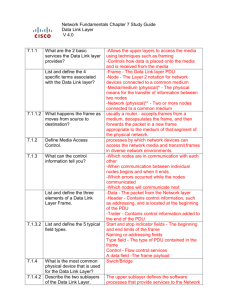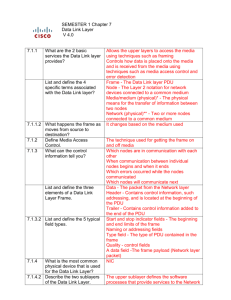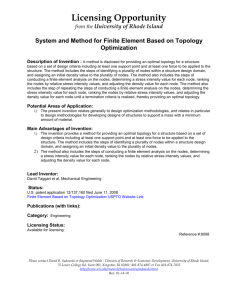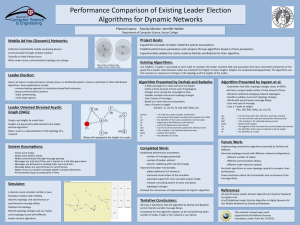CISCO Network Fundamentals Online Course V
advertisement
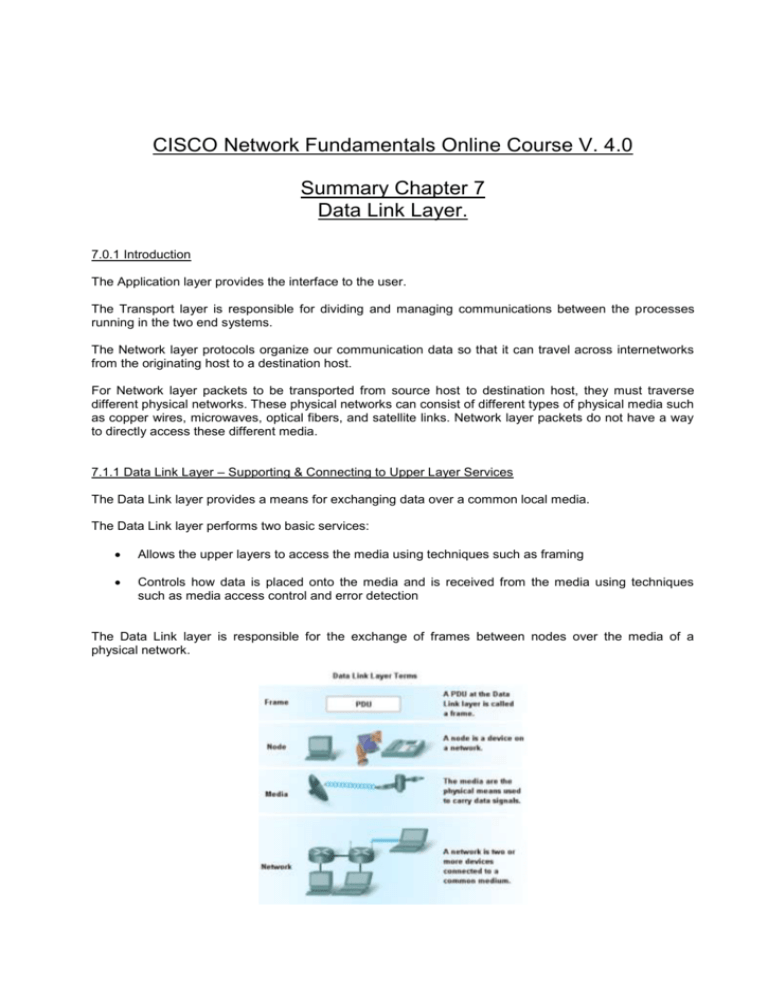
CISCO Network Fundamentals Online Course V. 4.0 Summary Chapter 7 Data Link Layer. 7.0.1 Introduction The Application layer provides the interface to the user. The Transport layer is responsible for dividing and managing communications between the processes running in the two end systems. The Network layer protocols organize our communication data so that it can travel across internetworks from the originating host to a destination host. For Network layer packets to be transported from source host to destination host, they must traverse different physical networks. These physical networks can consist of different types of physical media such as copper wires, microwaves, optical fibers, and satellite links. Network layer packets do not have a way to directly access these different media. 7.1.1 Data Link Layer – Supporting & Connecting to Upper Layer Services The Data Link layer provides a means for exchanging data over a common local media. The Data Link layer performs two basic services: Allows the upper layers to access the media using techniques such as framing Controls how data is placed onto the media and is received from the media using techniques such as media access control and error detection The Data Link layer is responsible for the exchange of frames between nodes over the media of a physical network. Upper Layer Access to Media The Data Link layer relieves the upper layers from the responsibility of putting data on the network and receiving data from the network. This layer provides services to support the communication processes for each medium over which data is to be transmitted. 7.1.2 Data Link Layer – Controlling Transfer Accross Local Media The technique used for getting the frame on and off media is called the media access control method. The media access control methods described by the Data Link layer protocols define the processes by which network devices can access the network media and transmit frames in diverse network environments. A node that is an end device uses an adapter to make the connection to the network. At intermediary devices such as a router, where the media type could change for each connected network, different physical interfaces on the router are used to encapsulate the packet into the appropriate frame, and a suitable media access control method is used to access each link. 7.1.3 Data Link Layer – Creating a Frame The Data Link layer frame includes: Data - The packet from the Network layer Header - Contains control information, such addressing, and is located at the beginning of the PDU Trailer - Contains control information added to the end of the PDU Formatting Data for Transmission When data travels on the media, it is converted into a stream of bits, or 1s and 0s. Framing breaks the stream into decipherable groupings, with control information inserted in the header and trailer as values in different fields. Typical field types include: Start and stop indicator fields - The beginning and end limits of the frame Naming or addressing fields Type field - The type of PDU contained in the frame Quality - control fields Data field -The frame payload (Network layer packet) Fields at the end of the frame form the trailer. These fields are used for error detection and mark the end of the frame. 7.1.4 Data Link Layer – Connecting Upper Layer Services to the Media In many cases, the Data Link layer is embodied as a physical entity, such as an Ethernet network interface card (NIC), which inserts into the system bus of a computer and makes the connection between running software processes on the computer and physical media. Data Link Sublayers To support a wide variety of network functions, the Data Link layer is often divided into two sublayers: an upper sublayer and an lower sublayer. The upper sublayer defines the software processes that provide services to the Network layer protocols. The lower sublayer defines the media access processes performed by the hardware. The two common LAN sublayers are: Logical Link Control Logical Link Control (LLC) places information in the frame that identifies which Network layer protocol is being used for the frame. Media Access Control Media Access Control (MAC) provides Data Link layer addressing and delimiting of data according to the physical signaling requirements of the medium and the type of Data Link layer protocol in use. 7.1.5 Data Link Layer – Standards The functional protocols and services at the Data Link layer are described by engineering organizations such as: International Organization for Standardization (ISO) Institute of Electrical and Electronics Engineers (IEEE) American National Standards Institute (ANSI) International Telecommunication Union (ITU) 7.2.1 Placing Data on the Media Regulating the placement of data frames onto the media is known as media access control. The method of media access control used depends on: Media sharing - If and how the nodes share the media Topology - How the connection between the nodes appears to the Data Link layer 7.2.2 Media Access Control for Shared Media There are two basic media access control methods for shared media: Controlled - Each node has its own time to use the medium Contention-based - All nodes compete for the use of the medium Controlled Access for Shared Media When using the controlled access method, network devices take turns, in sequence, to access the medium. Contention-based Access for Shared Media Also referred to as non-deterministic, contention-based methods allow any device to try to access the medium whenever it has data to send. To prevent complete chaos on the media, these methods use a Carrier Sense Multiple Access (CSMA) process to first detect if the media is carrying a signal. If a carrier signal on the media from another node is detected, it means that another device is transmitting. Data collision is when two devices transmit at the same time. If this occurs, the data sent by both devices will be corrupted and will need to be resent. CSMA is usually implemented in conjunction with a method for resolving the media contention. The two commonly used methods are: CSMA/Collision Detection In CSMA/Collision Detection (CSMA/CD), the device monitors the media for the presence of a data signal. If a data signal is absent, indicating that the media is free, the device transmits the data. If signals are then detected that show another device was transmitting at the same time, all devices stop sending and try again later. CSMA/Collision Avoidance In CSMA/Collision Avoidance (CSMA/CA), the device examines the media for the presence of a data signal. If the media is free, the device sends a notification across the media of its intent to use it. The device then sends the data. This method is used by 802.11 wireless networking technologies. 7.2.3 Media Access Control for Non-Shared Media In point-to-point topologies, the media interconnects just two nodes. Full Duplex and Half Duplex Half-duplex communication means that the devices can both transmit and receive on the media but cannot do so simultaneously. In full-duplex communication, both devices can transmit and receive on the media at the same time. 7.2.4 Logical Topology vs Physical Topology The topology of a network is the arrangement or relationship of the network devices and the interconnections between them. The physical topology is an arrangement of the nodes and the physical connections between them. A logical topology is the way a network transfers frames from one node to the next. This arrangement consists of virtual connections between the nodes of a network independent of their physical layout. These logical signal paths are defined by Data Link layer protocols. The Data Link layer "sees" the logical topology of a network when controlling data access to the media. It is the logical topology that influences the type of network framing and media access control used. The physical or cabled topology of a network will most likely not be the same as the logical topology. Logical and physical topologies typically used in networks are: Point-to-Point Multi-Access Ring 7.2.5 Point to Point Topology A point-to-point topology connects two nodes directly together. In point-to-point networks, if data can only flow in one direction at a time, it is operating as a half-duplex link. If data can successfully flow across the link from each node simultaneously, it is a full-duplex link. Logical Point-to-Point Networks The logical connection between nodes forms what is called a virtual circuit. A virtual circuit is a logical connection created within a network between two network devices. The media access method used by the Data Link protocol is determined by the logical point-to-point topology, not the physical topology. 7.2.6 Multi-Access Topology A logical multi-access topology enables a number of nodes to communicate by using the same shared media. Data from only one node can be placed on the medium at any one time. Every node sees all the frames that are on the medium, but only the node to which the frame is addressed processes the contents of the frame. The Data Link layer protocol specifies the media access control method that will provide the appropriate balance between frame control, frame protection, and network overhead. 7.2.7 Ring Topology In a logical ring topology, each node in turn receives a frame. Nodes in a logical ring topology remove the frame from the ring, examine the address, and send it on if it is not addressed for that node. In a ring, all nodes around the ring- between the source and destination node examine the frame. If there is no data being transmitted, a signal (known as a token) may be placed on the media and a node can only place a data frame on the media when it has the token. Remember that the Data Link layer "sees" a logical ring topology. The actual physical cabling topology could be another topology. 7.3.1 Data Link Layer Protocols – The Frame The Data Link layer protocol describes the features required for the transport of packets across different media. These features of the protocol are integrated into the encapsulation of the frame. When the frame arrives at its destination and the Data Link protocol takes the frame off the media, the framing information is read and discarded. 7.3.2 Framing – Role of the Header Frame control information is unique to each type of protocol. Typical frame header fields include: Start Frame field - Indicates the beginning of the frame Source and Destination address fields - Indicates the source and destination nodes on the media Priority/Quality of Service field - Indicates a particular type of communication service for processing Type field - Indicates the upper layer service contained in the frame Logical connection control field - Used to establish a logical connection between nodes Physical link control field - Used to establish the media link Flow control field - Used to start and stop traffic over the media Congestion control field - Indicates congestion in the media The field names above are nonspecific fields listed as examples. Different Data Link layer protocols may use different fields from those mentioned. 7.3.3 Addressing – Where The Frame Goes Device addresses at this layer are referred to as physical addresses. Physical addresses do not indicate on what network the device is located. If the device is moved to another network or subnet, it will still function with the same Layer 2 physical address. Because the frame is only used to transport data between nodes across the local media, the Data Link layer address is only used for local delivery. If the packet in the frame must pass onto another network segment, the intermediate device - a router will decapsulate the original frame, create a new frame for the packet, and send it onto the new segment. 7.3.4 Framing – Role of the Trailer Data Link layer protocols add a trailer to the end of each frame. The trailer is used to determine if the frame arrived without error. This process is called error detection. Error detection is accomplished by placing a logical or mathematical summary of the bits that comprise the frame in the trailer. Frame Check Sequence The Frame Check Sequence (FCS) field is used to determine if errors occurred in the transmission and reception of the frame. Error detection is added at the Data Link layer because this is where data is transferred across the media. To ensure that the content of the received frame at the destination matches that of the frame that left the source node, a transmitting node creates a logical summary of the contents of the frame. This is known as the cyclic redundancy check (CRC) value. This value is placed in the Frame Check Sequence (FCS) field of the frame to represent the contents of the frame. When the frame arrives at the destination node, the receiving node calculates its own logical summary, or CRC, of the frame. The receiving node compares the two CRC values. If the two values are the same, the frame is considered to have arrived as transmitted. If the CRC value in the FCS differs from the CRC calculated at the receiving node, the frame is discarded. 7.3.5 Data Link Layer Protocols – The Frame The actual Layer 2 protocol used depends on the logical topology of the network and the implementation of the Physical layer. Protocols that will be covered in CCNA courses include: Ethernet Point-to-Point Protocol (PPP) High-Level Data Link Control (HDLC) Frame Relay Asynchronous Transfer Mode (ATM) The Layer 2 protocol used for a particular network topology is determined by the technology used to implement that topology. Difference in bandwidth normally results in the use of different protocols for LANs and WANs. Ethernet Protocol for LANs Ethernet is a family of networking technologies that are defined in the IEEE 802.2 and 802.3 standards. The basic frame format and the IEEE sublayers of OSI Layers 1 and 2 remain consistent across all forms of Ethernet. However, the methods for detecting and placing data on the media vary with different implementations. Ethernet provides unacknowledged connectionless service over a shared media using CSMA/CD as the media access methods. The Ethernet frame has many fields, as shown in the figure. Ethernet II is the Ethernet frame format used in TCP/IP networks. Ethernet is such an important part of data networking, we have devoted a chapter to it. We also use it in examples throughout this series of courses. Point-to-Point Protocol for WANs Point-to-Point Protocol (PPP) is a protocol used to deliver frames between two nodes. PPP was developed as a WAN protocol and remains the protocol of choice to implement many serial WANs. PPP can be used on various physical media, including twisted pair, fiber optic lines, and satellite transmission, as well as for virtual connections. PPP also allows the two nodes to negotiate options within the PPP session. This includes authentication, compression, and multilink (the use of multiple physical connections). Wireless Protocol for LANs 802.11 is an extension of the IEEE 802 standards. The Standard IEEE 802.11, commonly referred to as Wi-Fi, is a contention-based system using a Carrier Sense Multiple Access/Collision Avoidance (CSMA/CA) media access process. 802.11 networks also use Data Link acknowledgements to confirm that a frame is received successfully. Other services supported by 802.11 are authentication, association (connectivity to a wireless device), and privacy (encryption). An 802.11 frame contains these fields: Protocol Version field - Version of 802.11 frame in use Type and Subtype fields - Identifies one of three functions and sub functions of the frame: control, data, and management To DS field - Set to 1 in data frames destined for the distribution system (devices in the wireless structure) From DS field - Set to 1 in data frames exiting the distribution system More Fragments field - Set to 1 for frames that have another fragment Retry field - Set to 1 if the frame is a retransmission of an earlier frame Power Management field - Set to 1 to indicate that a node will be in power-save mode More Data field - Set to 1 to indicate to a node in power-save mode that more frames are buffered for that node Wired Equivalent Privacy (WEP) field - Set to 1 if the frame contains WEP encrypted information for security Order field - Set to 1 in a data type frame that uses Strictly Ordered service class (does not need reordering) Duration/ID field - Depending on the type of frame, represents either the time, in microseconds, required to transmit the frame or an association identity (AID) for the station that transmitted the frame Destination Address (DA) field - MAC address of the final destination node in the network Source Address (SA) field - MAC address of the node the initiated the frame Receiver Address (RA) field - MAC address that identifies the wireless device that is the immediate recipient of the frame Transmitter Address (TA) field - MAC address that identifies the wireless device that transmitted the frame Sequence Number field - Indicates the sequence number assigned to the frame; retransmitted frames are identified by duplicate sequence numbers Fragment Number field - Indicates the number for each fragment of a frame Frame Body field - Contains the information being transported; for data frames, typically an IP packet FCS field - Contains a 32-bit cyclic redundancy check (CRC) of the frame 7.4.1 Follow Data Through an Internetwork #1. #2. #3. #4. #5. #6. #7. #8. #9. #10. #11. #12. #13. #14. #15. #16. #17. #18. #19. #20. #21. #22.
